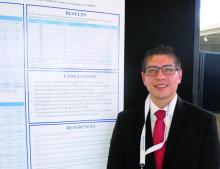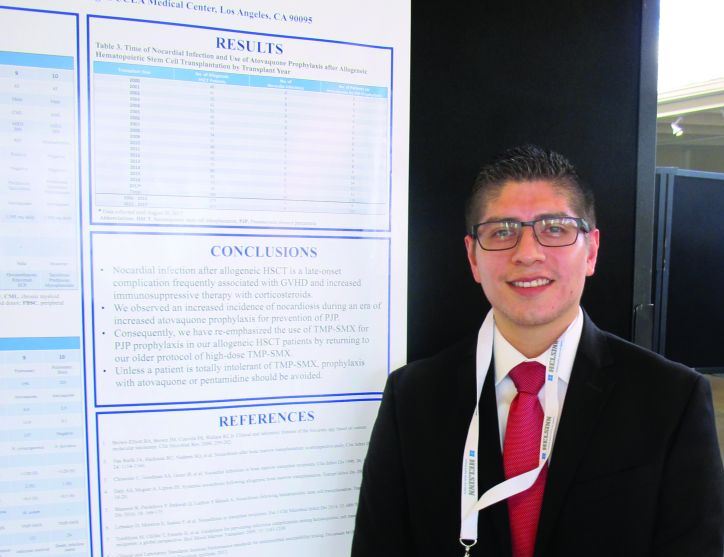User login
NEWPORT BEACH, CALIF. – Use of atovaquone or pentamidine for Pneumocystis jiroveci pneumonia (PJP) prophylaxis was associated with an increased incidence of nocardiosis in allogeneic hematopoietic stem call transplant (HSCT) recipients at the University of California, Los Angeles, according to a review of patient records.
Of 10 cases of late-onset nocardiosis identified among patients who received HSCT between Jan. 1, 2000, and Aug. 30, 2017, 9 cases occurred in 411 patients (2.2%) treated between 2012 and 2017 – a period of increased use of atovaquone prophylaxis, compared with only 1 in 575 patients (0.17%) treated in the prior 12 years when trimethoprim-sulfamethoxazole (TMP-SMX) was used for prophylaxis, Alfonso Molina reported in a poster at the Acute Leukemia Forum of Hemedicus.
None of the 575 patients treated between 2000 and 2012, versus 119 of the 411 treated after 2012, received atovaquone, he reported.
To assess the potential relationship between the use of atovaquone and the increased incidence of nocardiosis, he and his colleagues reviewed patient medical records and UCLA Clinical Microbiology Laboratory culture results.
Nocardiosis occurred mainly in patients on high doses of corticosteroids for graft-versus-host disease, and 8 of the 10 affected patients were not receiving TMP-SMX for PJP prophylaxis; 7 were on atovaquone, and 1 was on intravenous pentamidine, Mr. Molina said.
The findings suggest that TMP-SMX should remain the agent of choice for PJP prophylaxis in HSCT recipients and have prompted a return to the older protocol of high-dose TMP-SMX for this purpose at UCLA, he said.
“Unless a patient is totally intolerant of TMP-SMX, prophylaxis with atovaquone or pentamidine should be avoided,” he concluded.
Mr. Molina reported having no financial disclosures. The Acute Leukemia Forum is held by Hemedicus, which is owned by the same company as this news organization.
SOURCE: Molina A et al., ALF 2018, Poster Session.
NEWPORT BEACH, CALIF. – Use of atovaquone or pentamidine for Pneumocystis jiroveci pneumonia (PJP) prophylaxis was associated with an increased incidence of nocardiosis in allogeneic hematopoietic stem call transplant (HSCT) recipients at the University of California, Los Angeles, according to a review of patient records.
Of 10 cases of late-onset nocardiosis identified among patients who received HSCT between Jan. 1, 2000, and Aug. 30, 2017, 9 cases occurred in 411 patients (2.2%) treated between 2012 and 2017 – a period of increased use of atovaquone prophylaxis, compared with only 1 in 575 patients (0.17%) treated in the prior 12 years when trimethoprim-sulfamethoxazole (TMP-SMX) was used for prophylaxis, Alfonso Molina reported in a poster at the Acute Leukemia Forum of Hemedicus.
None of the 575 patients treated between 2000 and 2012, versus 119 of the 411 treated after 2012, received atovaquone, he reported.
To assess the potential relationship between the use of atovaquone and the increased incidence of nocardiosis, he and his colleagues reviewed patient medical records and UCLA Clinical Microbiology Laboratory culture results.
Nocardiosis occurred mainly in patients on high doses of corticosteroids for graft-versus-host disease, and 8 of the 10 affected patients were not receiving TMP-SMX for PJP prophylaxis; 7 were on atovaquone, and 1 was on intravenous pentamidine, Mr. Molina said.
The findings suggest that TMP-SMX should remain the agent of choice for PJP prophylaxis in HSCT recipients and have prompted a return to the older protocol of high-dose TMP-SMX for this purpose at UCLA, he said.
“Unless a patient is totally intolerant of TMP-SMX, prophylaxis with atovaquone or pentamidine should be avoided,” he concluded.
Mr. Molina reported having no financial disclosures. The Acute Leukemia Forum is held by Hemedicus, which is owned by the same company as this news organization.
SOURCE: Molina A et al., ALF 2018, Poster Session.
NEWPORT BEACH, CALIF. – Use of atovaquone or pentamidine for Pneumocystis jiroveci pneumonia (PJP) prophylaxis was associated with an increased incidence of nocardiosis in allogeneic hematopoietic stem call transplant (HSCT) recipients at the University of California, Los Angeles, according to a review of patient records.
Of 10 cases of late-onset nocardiosis identified among patients who received HSCT between Jan. 1, 2000, and Aug. 30, 2017, 9 cases occurred in 411 patients (2.2%) treated between 2012 and 2017 – a period of increased use of atovaquone prophylaxis, compared with only 1 in 575 patients (0.17%) treated in the prior 12 years when trimethoprim-sulfamethoxazole (TMP-SMX) was used for prophylaxis, Alfonso Molina reported in a poster at the Acute Leukemia Forum of Hemedicus.
None of the 575 patients treated between 2000 and 2012, versus 119 of the 411 treated after 2012, received atovaquone, he reported.
To assess the potential relationship between the use of atovaquone and the increased incidence of nocardiosis, he and his colleagues reviewed patient medical records and UCLA Clinical Microbiology Laboratory culture results.
Nocardiosis occurred mainly in patients on high doses of corticosteroids for graft-versus-host disease, and 8 of the 10 affected patients were not receiving TMP-SMX for PJP prophylaxis; 7 were on atovaquone, and 1 was on intravenous pentamidine, Mr. Molina said.
The findings suggest that TMP-SMX should remain the agent of choice for PJP prophylaxis in HSCT recipients and have prompted a return to the older protocol of high-dose TMP-SMX for this purpose at UCLA, he said.
“Unless a patient is totally intolerant of TMP-SMX, prophylaxis with atovaquone or pentamidine should be avoided,” he concluded.
Mr. Molina reported having no financial disclosures. The Acute Leukemia Forum is held by Hemedicus, which is owned by the same company as this news organization.
SOURCE: Molina A et al., ALF 2018, Poster Session.
REPORTING FROM ALF 2018
Key clinical point:
Major finding: The incidence of nocardiosis was 2.2% during atovaquone use versus 0.17% prior to its use.
Study details: A retrospective review of records for 986 patients.
Disclosures: Mr. Molina reported having no financial disclosures.
Source: Molina A et al. ALF 2018, Poster Session.

